Chippendale–
The Royalty of
Antique Furniture
by Bob Brooke
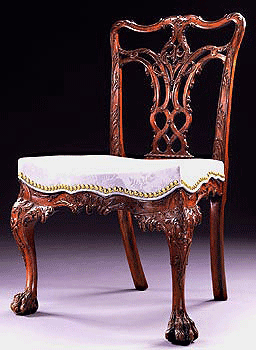 Of all the names associated
with antique furniture, Chippendale is the most well known. The
Chippendale style dominated American furniture until the 1770s. Known by
its exquisite and extensive carving, it takes its name from Thomas
Chippendale, an 18th century cabinetmaker, whose furnishings reflected
popular English tastes of the period incorporating English, Gothic, and
Chinese motifs. Of all the names associated
with antique furniture, Chippendale is the most well known. The
Chippendale style dominated American furniture until the 1770s. Known by
its exquisite and extensive carving, it takes its name from Thomas
Chippendale, an 18th century cabinetmaker, whose furnishings reflected
popular English tastes of the period incorporating English, Gothic, and
Chinese motifs.
Chippendale's early career remains a mystery.
Born in 1718 at Otley in West Yorkshire, England, son of carpenter John
Chippendale, and served his apprenticeship there. He had a great head
for business and as a social climber and self-publicist, he realized the
importance of public relations and advertising. In spite of his
membership of the Society of Arts and his fashionable wedding at St.
George's Chapel, Society never accepted him, except in his trade and
professional capacity.
The Early Years
But in 1754, Mr. Chippendale, as he was known in London,
published his detailed collection, Gentleman and Cabinet-Maker's
Director, a portfolio of fashionable English furniture design
templates and one of the first furniture design books. In it Chippendale
adapted existing design styles to the fashion of the mid-18th century.
Both makers and sellers of furniture rushed to purchase it, making
Chippendale a household name. And so pervasive was the influence of his
book that the name of Chippendale is often indiscriminately applied to
all mid-18th century furniture.
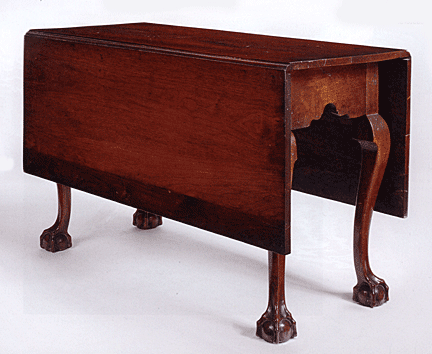 Chippendale created his Director as a
catalogue from which his wealthy patrons could choose particular
elements for their furniture, which would then be custom made for them
in his workshop. It contained 161 plates, reflecting many elements of
the Rococo, Chinese, Gothic and Neoclassical styles. Chippendale created his Director as a
catalogue from which his wealthy patrons could choose particular
elements for their furniture, which would then be custom made for them
in his workshop. It contained 161 plates, reflecting many elements of
the Rococo, Chinese, Gothic and Neoclassical styles.
Publication of the Director clearly had
a stimulating effect on Chippendale’s career since all his known
commissions date from after its publication. However, the Chippendale
style didn’t remain within the confines of the Chippendale workshops
very long. So popular were the designs with the wealthy class that soon
other furniture makers were using Gentleman and Cabinet-Maker’s
Director as a pattern book for their shops, too.
In 1754, the same year as the publication of
his Director, Chippendale moved to spacious premises in the
fashionable paved thoroughfare of St. Martin’s Lane which his firm
occupied for the next 60 years. He then formed a partnership with James
Rannie, a Scottish merchant, who injected capital into the business.
They employed between 40 and 50 artisans. And while the notes in his Director
showed Chippendale possessed a sound practical knowledge of timbers and
craftsmanship, he most likely, at this stage in his career, would have
been responsible for design and management, instead of working at the
bench.
A versatile man, he was willing to design and
supply wallpapers, carpets, fire grates, decorative ormolu, chimney
pieces, even complete room schemes, in addition to furniture. As well as
equipping State Apartments with luxurious ensembles, his firm regularly
supplied routine articles for the servants’ rooms and domestic
offices. He offered a complete house furnishing service, undertook
repairs, removals, hired out furniture, compiled inventories and was
even prepared to direct and furnish funerals for respected customers.
Fine
Woods Make the Difference
 Chippendale style furniture was generally made of mahogany, imported
from the West Indies. Though cabinetmakers occasionally used veneers,
they’re not typical of this style. Instead they preferred using solid
wood to accommodate the elaborate carving found in this style. And they
upholstered the newly introduced camel-back sofas in rich brocades,
velvets, and damasks. Chippendale style furniture was generally made of mahogany, imported
from the West Indies. Though cabinetmakers occasionally used veneers,
they’re not typical of this style. Instead they preferred using solid
wood to accommodate the elaborate carving found in this style. And they
upholstered the newly introduced camel-back sofas in rich brocades,
velvets, and damasks.
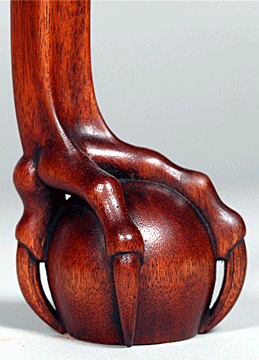 While cabinetmakers used Cuban, Dominican and
Honduran mahogany during the latter part of the 18th Century,
the finest was Cuban, a dense, heavy wood with a close grain. When they
carved it, minute white flecks would appear in the wood. Honduran
mahogany is lighter in weight and color. The mahoganies from the
Dominican Republic and Jamaica fell somewhere between Cuban and Honduran
in quality. Flame mahogany refers to the character of the grain,
obtained by using the first branch or crotch of the tree. Another much
sought-after grain was mottled, often referred to as "plum
pudding" mahogany. While cabinetmakers used Cuban, Dominican and
Honduran mahogany during the latter part of the 18th Century,
the finest was Cuban, a dense, heavy wood with a close grain. When they
carved it, minute white flecks would appear in the wood. Honduran
mahogany is lighter in weight and color. The mahoganies from the
Dominican Republic and Jamaica fell somewhere between Cuban and Honduran
in quality. Flame mahogany refers to the character of the grain,
obtained by using the first branch or crotch of the tree. Another much
sought-after grain was mottled, often referred to as "plum
pudding" mahogany.
Nevertheless, in the Chippendale period in
America, Connecticut cabinetmakers used cherry more often than mahogany.
During the same period, furniture makers in Bermuda used local cedar
which had an orangish hue. Throughout America, furniture makers used
softwoods like white pine for the main carcase of furniture, but in
England, they favored hardwood such as oak.
By mixing and melding the extravagant Rococo
style with the Gothic and Chinese styles, Chippendale came up with a
hybrid that displaced the more angular Queen Anne style. From the
1760's, the neoclassical work of architect Robert Adam, with whom he
worked on several large projects, influenced him greatly.
Chippendale's
Signature Form–The Cabriole Leg
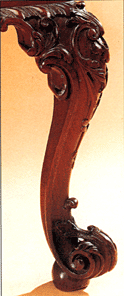 He extensively employed the Queen Anne-style cabriole leg. While
there are six different basic Chippendale style legs–the lion’s paw,
the ball and claw, the late Chippendale, the Marlborough, the club and
the spade–he based three of them on the cabriole shape which is an
elegant, serpentine style ending in a distinctive foot. These include
the lion’s paw, which ends with a lion paw shaped foot, the club,
which is a simple round foot and the ball and claw, which looks like an
eagle talon holding a ball. The remaining leg styles are straight–the
Marlborough being a plain, square leg, the spade a tapered round leg
often with a square or trapezoid foot, and the late Chippendale having a
square leg with a square foot. Chippendale’s Gothic and Chinese
influenced designs had straight or tapering legs, tracery carving and
fret and lattice work. He extensively employed the Queen Anne-style cabriole leg. While
there are six different basic Chippendale style legs–the lion’s paw,
the ball and claw, the late Chippendale, the Marlborough, the club and
the spade–he based three of them on the cabriole shape which is an
elegant, serpentine style ending in a distinctive foot. These include
the lion’s paw, which ends with a lion paw shaped foot, the club,
which is a simple round foot and the ball and claw, which looks like an
eagle talon holding a ball. The remaining leg styles are straight–the
Marlborough being a plain, square leg, the spade a tapered round leg
often with a square or trapezoid foot, and the late Chippendale having a
square leg with a square foot. Chippendale’s Gothic and Chinese
influenced designs had straight or tapering legs, tracery carving and
fret and lattice work.
Block-front furniture–where the center front
recedes in a shallow concave curve between slightly convex ends–seems
to have been unique to North America. Chippendale never illustrated
furniture of this type in his Director. Furniture connoisseurs
believe that this style originated the area of Boston, Massachusetts,
and assumed a Chippendale character.
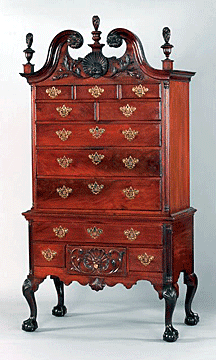 Another characteristically American furniture
form was the highboy. English cabinetmakers abandoned the
chest-on-stand, of the late 17th and early 18th centuries,
for the chest-on-chest where the lower section is supported on low
bracket feet. Furniture makers supported the highboy, known back then as
a high chest of drawers, on high cabriole legs, the top being surmounted
by a swan-neck broken pediment sometimes known in America as a
"bonnet." The center of the pediment was usually embellished
with a cartouche showing the family’s crest, except in American pieces
this is smaller. It was customary to display these elaborately carved
pieces in the drawing room, even though they were designed to hold
personal belongings. The lowboy, or the lower part of the
highboy, was usually elaborately embellished with carving and sometimes
stood by itself. Another characteristically American furniture
form was the highboy. English cabinetmakers abandoned the
chest-on-stand, of the late 17th and early 18th centuries,
for the chest-on-chest where the lower section is supported on low
bracket feet. Furniture makers supported the highboy, known back then as
a high chest of drawers, on high cabriole legs, the top being surmounted
by a swan-neck broken pediment sometimes known in America as a
"bonnet." The center of the pediment was usually embellished
with a cartouche showing the family’s crest, except in American pieces
this is smaller. It was customary to display these elaborately carved
pieces in the drawing room, even though they were designed to hold
personal belongings. The lowboy, or the lower part of the
highboy, was usually elaborately embellished with carving and sometimes
stood by itself.
Chippendale chairs often exhibit features of
Queen Anne or early Georgian furniture. Often, American Chippendale
chairs had Queen Anne back-splats or kidney-shaped seats. American
cabinetmakers used doweled through tenon construction, even in
sophisticated furniture, up to the late 18th century. In England this
feature had died out in all but country furniture by the early 18th
century. Of course, there are exceptions, so that identification is
dependent upon more subtle points such as the less extreme line of the
American back leg as compared with the English examples which are less
vertical. However, in America, cabriole legs tended to be somewhat
curlier than in England.
Chinese
Chippendale
Another style of furnishing that’s often associated with the name
of Chippendale is the so-called "Chinese Chippendale" or
Chinoiserie, which remained immensely popular, especially for bedrooms, despite
the rise of Neoclassicism. Japanning, or painted decoration sometimes
imitating lacquer, became the last word in chic.
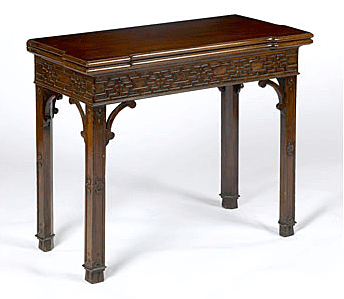 While he based his work upon the general Queen
Anne and Georgian characteristics of sober design and thoroughly fine
construction, retaining many of the early 18th-century details,
Chippendale introduced many other forms. Though collectors identify his
name with the extensive variety of chair designs—from geometrical to
Chinese, lattice, or sumptuously carved and interlaced forms, his
workshop’s output also included desks, mirror frames, hanging
bookshelves, settees, china cabinets and bookcases–featuring fretted
cornices and latticework glazed doors–and tables with delicately
fretted galleries and distinctive cluster-column legs of Gothic
inspiration. While he based his work upon the general Queen
Anne and Georgian characteristics of sober design and thoroughly fine
construction, retaining many of the early 18th-century details,
Chippendale introduced many other forms. Though collectors identify his
name with the extensive variety of chair designs—from geometrical to
Chinese, lattice, or sumptuously carved and interlaced forms, his
workshop’s output also included desks, mirror frames, hanging
bookshelves, settees, china cabinets and bookcases–featuring fretted
cornices and latticework glazed doors–and tables with delicately
fretted galleries and distinctive cluster-column legs of Gothic
inspiration.
What
Collectors Should Look For
Many fine pieces of furniture have been
attributed to Thomas Chippendale, but verifiable pieces are rare.
Chippendale never employed a maker’s mark, so the only method of
establishing his authorship is to find one of his original bills,
usually preserved among estate papers, or equivalent documentation.
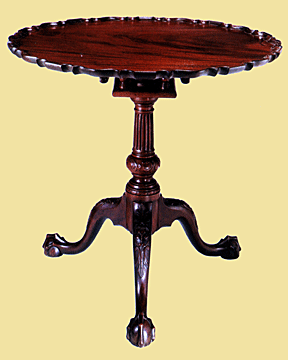 Even when a piece can be attributed with
certainty to Chippendale's workshop, it’s impossible to say for
certain that he worked on the furniture himself. As the Chippendale firm
became successful, his workmen, rather than Chippendale himself, carried
out more of the work. Even when a piece can be attributed with
certainty to Chippendale's workshop, it’s impossible to say for
certain that he worked on the furniture himself. As the Chippendale firm
became successful, his workmen, rather than Chippendale himself, carried
out more of the work.
Another feature of 18th century Chippendale
furniture was its irregularity. Cabinetmakers did all the work on this
furniture by hand, thus it won’t match the exact regularity of machine
work. According to John Nye, director of the American furniture
department at Sotheby’s in New York, when examining a piece of
Chippendale furniture to determine its age, collectors should look at
the joinery closely. Hand crafted joints will be slightly irregular and
may evidence tool marks, too.
Chair makers created detailed and deeply carved
legs with precise joints, as well as stretchers, the horizontal rungs
between chair legs for their Chippendale-style chairs. Seats were wood,
upholstered or caned in either a rectangular or kidney shape.
Chair backs varied with the intended function
of the chair. There were upholstered backs, rail backs, ladder backs,
rung backs, splat backs, and carved backs. As with the legs, chair
makers carved these deeply, with crisp details and often pierced them.
Noted
Makers of Chippendale Furniture
Records dating from before the American Revolution prove that there
were many skilled craftsmen in the country. In Boston, for example,
there were 150 known cabinetmakers, while Philadelphia had equally as
many. In the South, craftsmen-slaves produced good work. It’s not
surprising, therefore, to discover that many of the cabinetmakers who
produced American Chippendale furniture weren’t of British descent.
George Gostelowe who worked in Philadelphia was Swedish while Andrew
Gautier was a Huguenot.
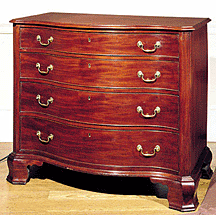 Some of the most remarkable makers of
Chippendale furniture were Quakers, for example the Goddards and the
Townsends of Newport, Rhode Island Island, and William Savery of
Philadelphia, Pennyslvania. In the history of American colonial
furniture, the Townsends and the Goddards are truly remarkable for the
quality of their work and for the number of them of different
generations who made furniture–altogether some 20 individuals from
three generations of the Townsends, including Christopher and his sons
John and Job and his grandsons Job junior and Edmund were well known,
while of the Goddards the best known was John. Some of the most remarkable makers of
Chippendale furniture were Quakers, for example the Goddards and the
Townsends of Newport, Rhode Island Island, and William Savery of
Philadelphia, Pennyslvania. In the history of American colonial
furniture, the Townsends and the Goddards are truly remarkable for the
quality of their work and for the number of them of different
generations who made furniture–altogether some 20 individuals from
three generations of the Townsends, including Christopher and his sons
John and Job and his grandsons Job junior and Edmund were well known,
while of the Goddards the best known was John.
Reproductions
It was the practice in the mid-18th Century to purchase a finely
made piece of furniture or decorative object and then have copies made
at a lower price to increase its number. These, as with modern
reproductions, of the Chippendale style were often hand carved but don’t
have the depth and detail of carving that genuine Chippendale furniture
has. Nye recommended that collectors look for evidence of craftsmanship–hand
planing, hand sawing, handmade nails, as well as shrinkage in the wood.
In addition, reproduction pieces will have been constructed of younger
mahogany which isn’t as dense and is grainier than the slow-growth
wood used to make 18th-century pieces.
High
Prices for Quality
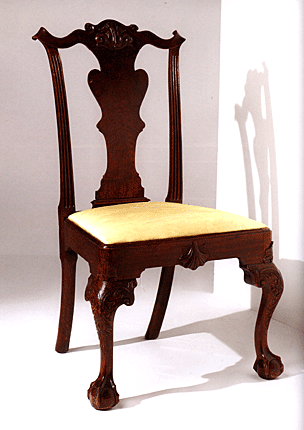 Thomas Chippendale, who’s furniture designs today command
stratospheric prices, had to, on more than one occasion, fight for
payment on his commissions. Today, collectors should be wary of any
piece of Chippendale furniture that doesn’t have a four to six-figure
price tag, especially for pieces made in Philadelphia, according to Nye.
"If it’s not appropriately priced, the dealer knows that it’s
not 18th century," said Nye. "A reputable dealer will give a
written guarantee that the piece is authentic and the guarantee will
include a detailed description of the piece and its provenance. Watch
out for the ‘too-good-to-be-true’ price." Thomas Chippendale, who’s furniture designs today command
stratospheric prices, had to, on more than one occasion, fight for
payment on his commissions. Today, collectors should be wary of any
piece of Chippendale furniture that doesn’t have a four to six-figure
price tag, especially for pieces made in Philadelphia, according to Nye.
"If it’s not appropriately priced, the dealer knows that it’s
not 18th century," said Nye. "A reputable dealer will give a
written guarantee that the piece is authentic and the guarantee will
include a detailed description of the piece and its provenance. Watch
out for the ‘too-good-to-be-true’ price."
Nye also noted that while the market is strong
for exceptional items, many Chippendale pieces are undocumented and
unsigned, so collectors need to look at form and aesthetic attributes.
"Many American cabinetmakers borrowed liberally from Chippendale’s
designs, so their pieces weren’t as pure as English ones," he
added.
The Chippendale Society, founded in England in
1963, owns an important collection of furniture and documents, usually
on display at Temple Newsam House, Leeds, England.
To read
more of my articles, please
visit
my Web site.
<
Back to Antiques Articles
Next Article > |
